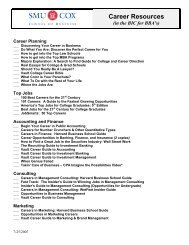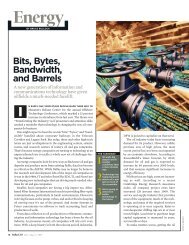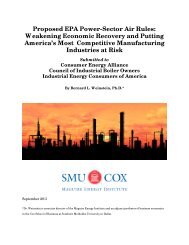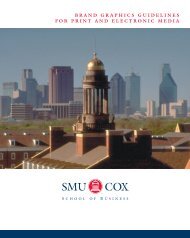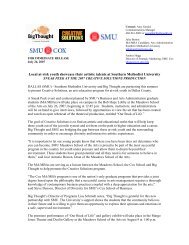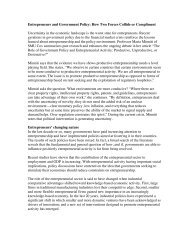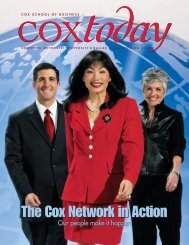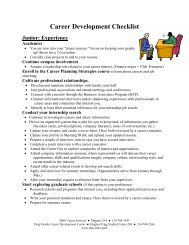Lessons from the Texas Homeowners Insurance Crisis Bob Puelz ...
Lessons from the Texas Homeowners Insurance Crisis Bob Puelz ...
Lessons from the Texas Homeowners Insurance Crisis Bob Puelz ...
You also want an ePaper? Increase the reach of your titles
YUMPU automatically turns print PDFs into web optimized ePapers that Google loves.
<strong>Lessons</strong> <strong>from</strong> <strong>the</strong> <strong>Texas</strong> <strong>Homeowners</strong> <strong>Insurance</strong> <strong>Crisis</strong><br />
<strong>Bob</strong> <strong>Puelz</strong>*<br />
*Dexter Professor of <strong>Insurance</strong>, Edwin L. Cox School of Business, Sou<strong>the</strong>rn Methodist<br />
University, Dallas, TX 75275. rpuelz@mail.cox.smu.edu. I am grateful to Mark Browne and<br />
anonymous referees for helpful comments on an earlier draft, and to research support of Amy<br />
<strong>Puelz</strong>, Kofi Boaitey, Melissa Jennings, Shirlene Pearson and especially Jean Salvati who<br />
provided econometric guidance. Finally, thanks to Gary Gola and Julie Jones at <strong>the</strong> <strong>Texas</strong><br />
Department of <strong>Insurance</strong> for data assistance and <strong>the</strong> Southwestern <strong>Insurance</strong> Information<br />
Services for providing a grant to fund <strong>the</strong> initial stages of this research.
<strong>Lessons</strong> <strong>from</strong> <strong>the</strong> <strong>Texas</strong> <strong>Homeowners</strong> <strong>Insurance</strong> <strong>Crisis</strong><br />
Abstract<br />
In this paper <strong>the</strong> recent crisis in <strong>the</strong> <strong>Texas</strong> homeowners insurance<br />
market is examined by focusing on three questions. First, how did <strong>the</strong><br />
dual regulatory system influence insurer behavior? Second, which perils<br />
were important in driving <strong>the</strong> increase in prices observed during <strong>the</strong> time<br />
period of this study? Third, were o<strong>the</strong>r non-expected loss factors related<br />
to premiums leaving consumers in <strong>the</strong> potential position of<br />
misunderstanding why overall price increases were arising? The<br />
findings reported indicate that <strong>the</strong> market shifted to entities that were not<br />
subject to rate regulation and that, among perils, water losses were most<br />
important in <strong>the</strong>ir association with price levels. In addition, prior period<br />
losses and unexpected loss deviations were statistically related to current<br />
prices likely exacerbating consumer misunderstanding about why <strong>the</strong>y<br />
were experiencing increases in <strong>the</strong>ir premiums. An implication <strong>from</strong> this<br />
crisis for regulatory authorities is that quick understanding <strong>the</strong>n<br />
communication is crucial to ameliorating market disruption.
I. Introduction<br />
<strong>Lessons</strong> <strong>from</strong> <strong>the</strong> <strong>Texas</strong> <strong>Homeowners</strong> <strong>Insurance</strong> <strong>Crisis</strong><br />
Whenever insurance markets show stress <strong>the</strong>re is an opportunity for researchers to reflect<br />
on evident consumer anger, managerial reactions and regulatory responses. Indeed, when <strong>the</strong><br />
insurance environment is in a condition that brings political and economic stakeholders to a<br />
common table, an experiment is created that permits exploration of a) why <strong>the</strong> problem was<br />
created; and b) <strong>the</strong> thornier issue of how <strong>the</strong> problem can be interpreted so differently across<br />
stakeholders. The recent crisis in <strong>the</strong> <strong>Texas</strong> homeowners insurance market provided such a case.<br />
Consumers became frustrated over prices and benefits, insurer management was challenged to<br />
find profitability in <strong>the</strong> homeowners line and regulators carried <strong>the</strong> burden of weighing protecting<br />
<strong>the</strong> people versus ensuring insurance companies’ solvency and ample supply. Questions remain<br />
about which factors caused upward price pressure and <strong>the</strong> role, if any, of a dual regulatory<br />
system of regulated and non-regulated rates that was in existence during <strong>the</strong> time of this crisis.<br />
The <strong>the</strong>oretical approach taken in this paper is grounded in <strong>the</strong> regulatory policy work of<br />
Meier (1991, 1998) whose <strong>the</strong>sis, when applied to insurance, suggests that regulatory policy<br />
changes depend on <strong>the</strong> competence and expertise of <strong>the</strong> insurance department vis-à-vis insurance<br />
consumer interest groups, insurer interest groups and <strong>the</strong> “political elites.” 1 Two challenges<br />
confronted by stakeholders in <strong>the</strong> <strong>Texas</strong> homeowners insurance crisis were product complexity<br />
and <strong>the</strong> differing consumer perceptions of <strong>the</strong> costs and benefits under <strong>the</strong> contract, fur<strong>the</strong>r<br />
widening misunderstandings and challenging regulatory policy-making. For example, consider<br />
<strong>the</strong> scenario of an insurance customer who received substantial premium increases even though<br />
1 See Licari (1998) for a general discussion of <strong>the</strong> framework of regulatory policy.<br />
1
<strong>the</strong> customer never filed a claim. Often, such customers discount <strong>the</strong> anxiety reduction benefit of<br />
insurance and focus on <strong>the</strong> relationship between <strong>the</strong>ir rising price and self-perceived risk, even if<br />
that perception is not well informed, a phenomenon that Svenson (1981) has documented in <strong>the</strong><br />
auto insurance market. When additional price increases occur unexpectedly, consumer discontent<br />
is taken to a higher level.<br />
The practical objectives of this research are to shed light on a) whe<strong>the</strong>r particular perils<br />
were predominate in <strong>the</strong>ir effect on homeowners insurance prices; b) <strong>the</strong> extent to which<br />
observable prices embody information beyond expected losses that include deviations and o<strong>the</strong>r<br />
elements not easily understand by consumers; and c) <strong>the</strong> extent to which insurers and <strong>the</strong>ir<br />
customers were being switched to non-regulated carriers, or at least away <strong>from</strong> regulated carriers.<br />
As will be discussed, this research provides an analysis of <strong>the</strong> peril-specific relationship of<br />
changes in homeowners premiums and includes measuring <strong>the</strong> relationship between loss lags and<br />
o<strong>the</strong>r uncertainty deviations that may be difficult for consumers to understand, <strong>the</strong>reby giving<br />
policymakers insight into <strong>the</strong> negative consumer sentiment during this crisis. Evidence offered<br />
herein shows water losses stood out in <strong>the</strong>ir impact on premiums and that a lagged loss history<br />
and a factor for unexpected deviations were statistically significant in <strong>the</strong>ir association with<br />
premiums in <strong>the</strong> <strong>Texas</strong> homeowners insurance market.<br />
The balance of this study proceeds as follows. In Part II, a brief background into <strong>the</strong><br />
<strong>Texas</strong> political and insurance climate during <strong>the</strong> recent homeowners insurance crisis is<br />
considered, along with a market analysis of <strong>the</strong> dual regulatory system that existed during <strong>the</strong><br />
time. In Part III, a preliminary analysis of insurance company performance in <strong>the</strong> <strong>Texas</strong><br />
homeowners market for regulated and non-regulated entities is contrasted with California and<br />
2
Illinois with company-level data to address whe<strong>the</strong>r homeowners insurance costs have been<br />
rising for insurers. These states were chosen, in part, because a) <strong>the</strong>y have experienced changes<br />
to insurance regulation; b) <strong>the</strong>ir size; and c) <strong>the</strong> availability of data that permits a contrast to<br />
<strong>Texas</strong>. In Part IV, a more rigorous empirical analysis is outlined and a panel data set is<br />
discussed. The data, supplied by <strong>the</strong> <strong>Texas</strong> Department of <strong>Insurance</strong>, range across <strong>the</strong> years<br />
1996 through 2001. In this section, groundwork is developed to assess particular perils that are<br />
predominate in <strong>the</strong>ir effect on homeowners insurance prices and <strong>the</strong> extent to which observable<br />
prices embody information beyond expected losses. Part V sets out <strong>the</strong> findings of <strong>the</strong> testing<br />
and Part VI contains concluding observations.<br />
II. Background<br />
The <strong>Texas</strong> insurance environment is well populated (22 million people) and has displayed<br />
<strong>the</strong> attributes of substantial changes in insurance prices while maintaining both a regulated and a<br />
deregulated environment for <strong>the</strong> same coverage. The crisis analyzed in this paper had<br />
implications beyond <strong>the</strong> insurance market to <strong>the</strong> real estate market and <strong>the</strong> interest of lenders. 2<br />
Moreover, insurers asserted that water-associated mold claims were at <strong>the</strong> heart of <strong>the</strong> problem,<br />
contending that <strong>the</strong> “policy never was intended to cover mold claims” and should not be treated<br />
as a dynamic contract subject to coverage interpretation over time. 3 On September 24, 2002,<br />
2 The <strong>Texas</strong> insurance problem has received <strong>the</strong> focus of <strong>the</strong> <strong>Texas</strong> A&M real estate center<br />
http://recenter.tamu.edu/tgrande/vol9-2/1556.html, which discusses home affordability when insurance prices are<br />
increasing. The breadth of <strong>Texas</strong> insurance markets is included in <strong>the</strong> insurance commissioner’s annual report. At<br />
<strong>the</strong> site http://www.tdi.state.tx.us/, one may find annual reports over <strong>the</strong> past few years and is a good source of<br />
information on a variety of insurance market elements, including specific insurers and <strong>the</strong> percentage of <strong>the</strong><br />
homeowners market <strong>the</strong>y hold. Additional author’s note: Links to Web sites reported in this paper might no longer<br />
exist in precisely <strong>the</strong> same syntax. Readers should contact <strong>the</strong> site owner or <strong>the</strong> link’s author to locate <strong>the</strong><br />
information referenced herein.<br />
3 Hartwig (2002) presents <strong>the</strong> mold coverage issue, www.iii.org/media/hottopics/insurance/mold2/. While<br />
<strong>the</strong> “mold exclusion” in homeowners policies is common across states, <strong>the</strong> interpretation of a water loss<br />
differentiates <strong>Texas</strong> <strong>from</strong> o<strong>the</strong>r states. As discussed by Hartwig (2002) in “Mold and <strong>Homeowners</strong> <strong>Insurance</strong>..,”<br />
3
<strong>the</strong> structure of <strong>the</strong> <strong>Texas</strong> homeowners insurance market appeared tenuous when Farmers, <strong>the</strong><br />
second-largest writer of homeowners contracts, announced <strong>the</strong>ir intention to cease writing or<br />
renewing homeowners insurance contracts in <strong>Texas</strong>. During this time frame, Green (2002) noted<br />
that consumer complaints about excessive rates in <strong>Texas</strong> rose 3,000% between <strong>the</strong> second quarter<br />
of 2001 and <strong>the</strong> second quarter of 2002, putting politicians on notice by <strong>the</strong>ir constituencies.<br />
Noteworthy to <strong>the</strong> debate was <strong>the</strong> observation that <strong>Texas</strong> law permitted a dual regulatory<br />
system, opening a path for insurers to sell contracts through non-rate regulated entities. In 1991,<br />
<strong>Texas</strong> moved to a +/- 30% benchmark flex-rate system for property insurance rates but left a<br />
loophole in <strong>the</strong> law that exempted Lloyd’s entities <strong>from</strong> this rating law, effectively omitting <strong>the</strong>m<br />
<strong>from</strong> <strong>the</strong> benchmark system. 4 State law clearly offered an incentive to insurers to switch blocks<br />
of policyholders to non-rate regulated underwriters or for customers to switch <strong>from</strong> a regulated<br />
insurer to a non-rate regulated insurer that might be in a different insurer group. Table 1<br />
suggests a migration took place to a market where prices were not regulated. 5 Media and<br />
subsequent political reactions linked deregulation and rising prices, implying that insured<br />
homeowners were being charged rates that were not justified. 6<br />
<strong>Texas</strong> policies “have historically covered damage arising <strong>from</strong> <strong>the</strong> continuous and repeated seepage of water. In<br />
virtually all o<strong>the</strong>r states, water damage — <strong>the</strong> most common cause of loss in homes — is covered only if it is of a<br />
sudden and accidental nature.”<br />
4 According to <strong>the</strong> <strong>Texas</strong> Department of <strong>Insurance</strong>, “Farm Mutual, County Mutual, Lloyd’s and Reciprocal<br />
Insurers are exempt <strong>from</strong> insurance laws unless specifically stated in its Chapter or unless <strong>the</strong> specific law actually<br />
names <strong>the</strong> type of company in <strong>the</strong> article.” For example, A Lloyd’s company exemption may be found in <strong>the</strong> <strong>Texas</strong><br />
<strong>Insurance</strong> Code, http://www.tdi.state.tx.us/commish/code.html. For discussion about this issue, see <strong>the</strong> research<br />
report prepared by <strong>the</strong> House Research Organization of <strong>the</strong> <strong>Texas</strong> House of Representatives,<br />
http://www.capitol.state.tx.us/hrofr/interim/int77-1.pdf, in which it is discussed that Lloyds companies were<br />
originally exempt <strong>from</strong> <strong>the</strong> 1991 benchmark pricing system because “<strong>the</strong>y comprised only 20% of <strong>the</strong> market and<br />
generally covered specialty risks at rates lower than <strong>the</strong> standard rates.”<br />
5 Ano<strong>the</strong>r important phenomenon might have also occurred that led to <strong>the</strong> movement by insurers to use an<br />
unregulated entity to insure customers. That is, Lloyd’s rates may have been lower for consumers than <strong>the</strong> regulated<br />
rates, which gave an opportunity to agents to increase agency market share. This would be encouraging anecdotal<br />
evidence of competitive activity in this market.<br />
6 By contrast, Brough (2001) and Harrington (2000) have argued that insurance consumers are best served<br />
by competition and deregulation. Moreover, as noted by a referee, <strong>the</strong> intention of opening a deregulated market<br />
4
[Table 1 about here]<br />
might have been for it to serve in place of a Fair Access to <strong>Insurance</strong> Requirements (FAIR) plan residual market<br />
alternative.<br />
5
To explore <strong>the</strong> movement fur<strong>the</strong>r, Table 2 details <strong>the</strong> results among <strong>the</strong> 10 leading insurer<br />
group writers of homeowners policies over this same period. Moving vertically down is <strong>the</strong><br />
descending rank of insurer groups by <strong>the</strong> overall quantity of premiums written over <strong>the</strong> 1996 to<br />
2001 period. The data utilized in assembling Table 2 was first examined by taking <strong>the</strong> total<br />
quantity of premiums written by an insurer group in a given year and seeing how <strong>the</strong> quantity<br />
was allocated between an insurer group’s non-regulated and regulated entities. In Table 2, <strong>the</strong><br />
focus is solely on <strong>the</strong> percentage of an insurer group’s business attributed to non-rate regulated<br />
sales. Focusing on <strong>the</strong> “big three” — State Farm, Farmers and Allstate — it is clear that an<br />
increasing proportion of <strong>the</strong>ir premiums were being allocated to <strong>the</strong> non-rate regulated sector.<br />
With <strong>the</strong> exception of USAA, <strong>the</strong> data in Table 2 reveal that if an insurer group was not selling<br />
fully via a non-rate regulated entity in 1996 that it was doing so by 2001. 7<br />
[Table 2 about here]<br />
III. Preliminary Analysis: Comparing California, Illinois and <strong>Texas</strong><br />
To put <strong>the</strong> <strong>Texas</strong> dual regulatory results in broader context, we begin by comparing <strong>the</strong><br />
<strong>Texas</strong> experience to California and Illinois during a similar time period because this permits a<br />
view into three of <strong>the</strong> five largest states that have contrasting regulatory dynamics and general<br />
data that were available. 8 The data are taken <strong>from</strong> annual report information filed by insurers<br />
7 The data in Tables 1 and 2 were received under a 2006 data request <strong>from</strong> <strong>the</strong> <strong>Texas</strong> Department of<br />
<strong>Insurance</strong>. Proportions in non-rate regulated entities vary only slightly <strong>from</strong> <strong>the</strong> data used to assemble Figure 1 and<br />
Table 3, which were originally compiled in 2002 under a different data request.<br />
8 See D’Arcy (2002) for a discussion of <strong>the</strong> Illinois deregulation experience. The California data came <strong>from</strong><br />
http://www.insurance.ca.gov/RRD/RSU/MktShr2001/MktShr2001.htm and <strong>the</strong> Illinois data came <strong>from</strong><br />
http://www.ins.state.il.us/, where in <strong>the</strong> latter <strong>the</strong> loss ratios for 1997 and 1998 are approximated <strong>from</strong> Figure 11 in<br />
this annual report. <strong>Texas</strong> data came originally <strong>from</strong> <strong>the</strong> site http://www.tdi.state.tx.us/general/forms/tdirpts.html.<br />
All data sets were originally assembled in 2002. Loss ratios do not consider o<strong>the</strong>r factors that positively affect an<br />
insurer’s profitability such as investment income and capital gains, yet it is a ratio widely considered by insurance<br />
management and regulatory overseers.<br />
6
with <strong>the</strong> NAIC, and were sourced for this study <strong>from</strong> state-assembled datasets. Statutory page<br />
14 of <strong>the</strong> annual report is a premium and expense exhibit that focuses on premiums, losses and<br />
expenses attributable by line of insurance and by state. The analysis considers all insurance<br />
entities that sold homeowners insurance in <strong>Texas</strong> <strong>from</strong> 1996 through 2001. It includes insurers<br />
that wrote policies in both price-unregulated companies and price-regulated companies. Thus,<br />
not only is it of interest to examine whe<strong>the</strong>r insurers have experienced rising costs, but also were<br />
<strong>the</strong> non-regulated companies, where prices are unconstrained by regulatory mandate, more<br />
profitable for insurers?<br />
Figure 1 and Table 3 depict loss ratio experience for homeowners contracts in <strong>the</strong><br />
California, Illinois and <strong>Texas</strong> markets. While <strong>the</strong> risk attributes of an insured home in one state<br />
are difficult to contrast with an insured home in ano<strong>the</strong>r state, <strong>the</strong> proportion of losses to<br />
premiums is comparable, particularly with regard to managerial sensitivity about <strong>the</strong> relative<br />
profitability of <strong>the</strong>se markets. From 1996 through 2001, <strong>the</strong> California experience in <strong>the</strong><br />
homeowners market was relatively stable, with a loss ratio fluctuating <strong>from</strong> a low of 0.48 in 1997<br />
to a high of 0.64 in 2001. The Illinois experience was somewhat “u-shaped” with a relatively<br />
high loss ratio in 1996 (0.93), stability in 1997 through 1999, followed by a upward movement to<br />
a high of 1.08 in 2001. By contrast, <strong>the</strong> <strong>Texas</strong> experience over <strong>the</strong>se years reveals a trend similar<br />
to Illinois but different <strong>from</strong> California, highlighted by <strong>the</strong> years where insurers had a loss ratio<br />
of 0.84 in 2000 and 1.18 in 2001; a losing business segment for <strong>the</strong> industry as a whole even<br />
before taking company expenses into account. 9<br />
9 Statistical tests for differences between California and <strong>Texas</strong> loss ratios were significant at only <strong>the</strong> 0.08<br />
level; however, <strong>the</strong> differences between Illinois and California, and Illinois and <strong>the</strong> <strong>Texas</strong> entities were statistically<br />
significant at <strong>the</strong> 0.01 level. The near-term trend in <strong>the</strong>se results appears to be consistent with <strong>the</strong> widespread<br />
concern over profitability by insurance executives, which is highlighted in <strong>the</strong> October 2002 presentation, “What’s<br />
Keeping CEOs Awake at Night?” by Robert P. Hartwig, http://www.iii.org/media/industry/outlooks/unitedstates/.<br />
7
[Figure 1 about here]<br />
[Table 3 about here]<br />
Fur<strong>the</strong>r, in Figure 1, it is of interest to note that insurer profitability in a deregulated environment<br />
such as Illinois is worse than <strong>the</strong> regulated <strong>Texas</strong> and California counterparts. While it may be<br />
<strong>the</strong> case that <strong>the</strong> deregulated market was composed of a higher-risk profile and pricing that did<br />
not anticipate this profile, ano<strong>the</strong>r view of <strong>the</strong> Illinois experience is that consumers were<br />
benefiting because of <strong>the</strong> closer relationship between premiums and losses. That is, taking <strong>the</strong><br />
view that losses arise as random events, <strong>the</strong>n <strong>the</strong> premium cushion in Illinois was small relative<br />
to <strong>the</strong> <strong>Texas</strong> and California experiences <strong>from</strong> 1996 through 2000, suggesting this deregulated<br />
insurance market was prone to reasonable pricing.<br />
IV. <strong>Texas</strong> <strong>Homeowners</strong> Experience<br />
Interstate comparisons aside, closer exploration within <strong>Texas</strong> also yields interesting<br />
findings. Recall <strong>from</strong> Table 1 that <strong>the</strong> predominant insuring intermediary for <strong>the</strong> <strong>Texas</strong><br />
homeowners market was <strong>the</strong> non-rate regulated entity; hence, overall industry profitability in <strong>the</strong><br />
homeowners market is heavily weighted toward this business form. While <strong>the</strong> non-rate regulated<br />
insurers had loss ratios in <strong>Texas</strong> below <strong>the</strong>ir rate-regulated counterparts <strong>from</strong> 1997 through 1999,<br />
this legal form experienced deterioration in <strong>the</strong>ir loss ratio sooner after 1999. In 2000, <strong>the</strong> loss<br />
ratio was much higher in <strong>the</strong> non-rate regulated entity, indicating that insurers’ overall operating<br />
performance suffered relative to <strong>the</strong> benefits received by consumers. Note, however, that rate-<br />
regulated performance by 2001 nearly caught up, because <strong>the</strong> slope of <strong>the</strong> trend line for<br />
companies that are rate regulated is more steeply sloped.<br />
8
To fur<strong>the</strong>r explore <strong>the</strong> <strong>Texas</strong> setting, Figure 2 provides a more complete view of<br />
profitability by considering approximated “combined” ratios of <strong>the</strong> top five writing entities in <strong>the</strong><br />
<strong>Texas</strong> homeowners market <strong>from</strong> 1996 through 2001. The entities — State Farm Lloyd’s,<br />
Allstate <strong>Texas</strong> Lloyd’s, Farmers <strong>Insurance</strong> Exchange, Fire <strong>Insurance</strong> Exchange and USAA —<br />
wrote about 68% of <strong>the</strong> <strong>Texas</strong> homeowners market in 2001. The results in Figure 2 illustrate <strong>the</strong><br />
upward trend in <strong>the</strong>se insurers’ homeowners losses <strong>from</strong> <strong>the</strong>ir most profitable point, 1998.<br />
Among <strong>the</strong> top five writers, USAA was clearly <strong>the</strong> most profitable entity yet its diminishing<br />
insurance profitability trend has been upward, too, though not as severe as <strong>the</strong>ir competitors.<br />
From 2000, <strong>the</strong> trend had been particular severe for State Farm Lloyd’s and Farmers <strong>Insurance</strong><br />
Exchange. In all cases, it appears that it would have been difficult for insurers to continue<br />
offering homeowners coverage without raising prices to consumers.<br />
[Figure 2 about here]<br />
Thus, it is clear that <strong>the</strong> insurance industry in <strong>Texas</strong> had been losing money underwriting<br />
homeowners insurance in this market, and <strong>the</strong> rate at which <strong>the</strong>y were losing money was trending<br />
higher for rate-regulated companies. This leads to a regulatory conundrum: While capping or<br />
lowering rates may be, in <strong>the</strong> short-run, politically appealing, <strong>the</strong> prospect of moving to a more<br />
rate-regulated environment moves insurance management into a box. On <strong>the</strong> one hand,<br />
insurance firms are about taking risk; that is what <strong>the</strong>y do. On <strong>the</strong> o<strong>the</strong>r hand, no business<br />
proposition where a product or service has expected costs that exceed its expected revenue ought<br />
to be offered. In this event, management is better off doing nothing ra<strong>the</strong>r than participating.<br />
9
This may have been part of Farmers strategy to announce <strong>the</strong>ir intention to not sell homeowners<br />
insurance. 10<br />
While it appears clear that insurers have not done well in <strong>the</strong> <strong>Texas</strong> homeowners<br />
insurance market, <strong>the</strong> aggregate data among market share leaders do not reveal <strong>the</strong> sources of<br />
<strong>the</strong>ir difficulty. To explore <strong>the</strong> source of losses by peril, a dataset compiled by <strong>the</strong> <strong>Texas</strong><br />
Department of <strong>Insurance</strong> (TDI) that attributes and isolates <strong>Texas</strong> losses by peril is examined<br />
across all insurers operating in <strong>Texas</strong>. The data include loss frequency and loss severity<br />
information for homeowners (HO), farm and ranch owners (FRO), tenants (TN) and dwelling<br />
(DW) for <strong>the</strong> 1996 through 2001 time period, although only homeowners data are used in <strong>the</strong><br />
subsequent analysis. Fur<strong>the</strong>r, <strong>the</strong> data are broken down by six perils, in particular, if <strong>the</strong> cause of<br />
loss was fire, wind, water, <strong>the</strong>ft, vandalism and malicious mischief (VMM), a catch-all “O<strong>the</strong>r”<br />
category for property losses not fitting into <strong>the</strong>se categories and, finally, a liability loss category,<br />
Section II of <strong>the</strong> homeowners contract. 11<br />
The loss data have <strong>the</strong> redeeming feature of being broken down by peril; however, losses<br />
represent only paid losses ra<strong>the</strong>r than paid losses plus an amount set in reserve for losses incurred<br />
but not yet paid. In o<strong>the</strong>r words, <strong>the</strong> data used in this section make insurers look more<br />
“profitable” than <strong>the</strong>ir economic reality. Losses defined as “incurred losses” were reported in <strong>the</strong><br />
data used in <strong>the</strong> preliminary analysis section because <strong>the</strong>y were available and arguably provide a<br />
fuller explanation of insurer contractual responsibility and insurance operating performance.<br />
Because paid losses and not incurred losses are used in this section, distinctions in annual loss<br />
10 The complete answer to Farmers strategy is no doubt more complicated and might have included political<br />
maneuvering, managerial and regulatory obstinacy and o<strong>the</strong>r positioning strategies.<br />
11 The data is derivied <strong>from</strong> <strong>the</strong> residential stat plan exhibits and includes premium and loss information<br />
associated with <strong>the</strong> <strong>Texas</strong> Windstorm <strong>Insurance</strong> Association (TWIA). According to Gary Gola of <strong>the</strong> TDI, “<strong>the</strong><br />
policy counts and Exposure for TWIA are not included as that would be double counting since <strong>the</strong> TWIA is a<br />
supplement to a regular <strong>Homeowners</strong> policy.”<br />
10
amounts are summarized in Table 4. Estimates for loss reserves can be substantial as reflected<br />
by <strong>the</strong> difference in columns (2) and (1) for <strong>the</strong> 2001 year, where incurred losses are about 22%<br />
greater than paid losses. 12<br />
[Table 4 about here]<br />
To explore “by peril” effects, <strong>the</strong> dollar value of a property loss claim <strong>from</strong> 1996 to 2001<br />
is reported in Table 5, “<strong>Texas</strong> Statewide HO Loss Information by Peril.” In this table, <strong>the</strong> dollar<br />
amount of loss is normalized per policy and by <strong>the</strong> dollar value of exposure in each year; <strong>the</strong><br />
latter being a statistic that is sensitive to changes in building costs and inflation. 13 Examining<br />
columns (1) and (2) reveals that <strong>the</strong> magnitude of wind and water claims bears a substantial<br />
weight in total loss costs. Fur<strong>the</strong>rmore, while fire, wind, <strong>the</strong>ft and VMM have been relatively<br />
stable contributors to loss costs over time, <strong>the</strong> magnitude of water losses more than doubled<br />
between 2000 and 2001 on a per policy and a per $1,000 of exposure basis. The O<strong>the</strong>r and<br />
Liability categories showed an increasing percentage change in severity <strong>from</strong> 1996 to 2001 on a<br />
per policy and per $1,000 exposure basis. 14<br />
[Table 5 about here]<br />
[Figure 3 about here]<br />
12 The substantial differences between paid and incurred losses during <strong>the</strong> latter years of <strong>the</strong> period<br />
examined might exist due to <strong>the</strong> protracted settlement process of mold claims.<br />
13 See http://www.casact.org/pubs/dpp/dpp90/90dpp559.pdf .<br />
14 The information used in <strong>the</strong> Table 5 and Figures 3 through 5 was found originally (2002) at <strong>the</strong> <strong>Texas</strong><br />
Department of <strong>Insurance</strong> Web site, http://www.tdi.state.tx.us/general/forms/tdirpts.html, that, according to Gary<br />
Gola at <strong>the</strong> TDI r<br />
11
Figure 3 illustrates <strong>the</strong> change in statewide dollar losses for property perils over time<br />
scaled for total statewide insurance company exposure. While fire, <strong>the</strong>ft, VMM, liability and <strong>the</strong><br />
o<strong>the</strong>r peril category have shown only modest changes, wind and water perils are much more<br />
variable with <strong>the</strong> water peril exhibiting a substantially increasing rate of change <strong>from</strong> 1999 to<br />
2001.<br />
Given that <strong>the</strong> dataset is detailed by county, it is possible to explore how a particular<br />
county’s by-peril distribution of losses is contrasted with <strong>the</strong> overall state. That is, <strong>the</strong> fire, wind,<br />
water and <strong>the</strong>ft perils loss costs compared to total loss costs suffered by county residents for a<br />
given year. This historical pattern of losses is benchmarked against <strong>Texas</strong> statewide proportions<br />
so that county constituents can assess how <strong>the</strong>ir actual experience has faired relative to statewide<br />
averages, although it is important to note that geographical location brings <strong>the</strong> magnitude of risks<br />
to bear across counties differentially. As an example, Figure 4 provides a graphical<br />
representation of four major property perils for Harris County, <strong>Texas</strong> (<strong>the</strong> Houston area) because,<br />
according to <strong>the</strong> U.S. Census Bureau, it is <strong>the</strong> largest county in <strong>the</strong> state. 15 Moving vertically, <strong>the</strong><br />
first four charts show <strong>the</strong> dollar proportion of losses by peril for Harris County relative to <strong>the</strong><br />
statewide averages of <strong>Texas</strong>’s 254 counties. The bottom chart in Figure 4 is a view of Harris<br />
County’s homeowners total paid losses relative to total premiums paid, or a paid loss ratio.<br />
While this measure incorporates only paid benefits received by consumers <strong>from</strong> <strong>the</strong> homeowners<br />
contract relative to <strong>the</strong> costs (<strong>the</strong> premiums paid), it excludes <strong>the</strong> administrative costs of <strong>the</strong><br />
homeowners product and reserves set aside by insurers for losses not yet paid; <strong>the</strong>refore, it is an<br />
upwardly biased measure of insurer profitability. 16<br />
15<br />
A similar analysis has been done on each of <strong>the</strong> 254 <strong>Texas</strong> counties and can be obtained <strong>from</strong> <strong>the</strong> author<br />
upon request.<br />
16<br />
The by-peril annual data represent paid losses and not incurred losses. Still, <strong>from</strong> an insurance<br />
management view, <strong>the</strong> information can be useful for identifying problems or opportunities, hence strategy.<br />
12
[Figure 4 about here]<br />
One glimpse into <strong>the</strong> sources of rising claims is to focus on <strong>the</strong> water peril because<br />
problems associated with mold were <strong>the</strong> “hot button” insurance issue in <strong>Texas</strong>. The value of a<br />
paid water loss per policy by county was considered in 1996 and in 2001 and <strong>the</strong> percentage<br />
change calculated for each county. While a few, particularly small, counties had no water losses<br />
in ei<strong>the</strong>r 1996 or 2001 and, thus, were removed <strong>from</strong> consideration in Figure 5, 246 of <strong>Texas</strong>’<br />
254 counties remained for this descriptive analysis. The cumulative distribution histogram<br />
reveals a spread in <strong>the</strong> water loss value changes, and <strong>the</strong> notable fact that about two-thirds of<br />
<strong>Texas</strong> counties experienced at least a 100% increase in <strong>the</strong> value of a paid water loss on a per<br />
policy basis. By contrast, a similar analysis for <strong>the</strong> fire peril indicates that about two-thirds of<br />
<strong>Texas</strong> counties had a change in <strong>the</strong> value of a fire loss per policy of up to 25%, with more than<br />
half of <strong>the</strong> counties showing a negative change in value <strong>from</strong> 1996 to 2001.<br />
V. Hypo<strong>the</strong>sis Testing and Empirical Results<br />
[Figure 5 about here]<br />
To obtain a clearer understanding about <strong>the</strong> <strong>Texas</strong> homeowners market, <strong>the</strong> questions<br />
addressed in this study need an enhanced analytical framework. The work of Klein and Grace<br />
(2001) provides a useful perspective for empirical testing in homeowners insurance markets; in<br />
particular, <strong>the</strong>ir clarity on <strong>the</strong> issue of a broader empirical framework for analysis that overcomes<br />
myopic inferences that can be made <strong>from</strong> examining data in only a tabular, univariate format. 17<br />
17 Klein and Grace (2001) provide a rigorous examination of red-lining in <strong>the</strong> <strong>Texas</strong> homeowners insurance<br />
market and find loss ratios “roughly equivalent” between ZIP codes distinguished by low and high minority<br />
representation; an extension of <strong>the</strong> work by Harrington and Niehaus (1998) in urban automobile insurance markets.<br />
In <strong>the</strong>ir econometric discussion, <strong>the</strong>y raise <strong>the</strong> issue of omitted variable bias; in this paper, <strong>the</strong> potential bias could<br />
13
In o<strong>the</strong>r words, a more complete empirical specification, where <strong>the</strong> relationships of interest are<br />
explored, while controlling for o<strong>the</strong>r county-specific factors that may be related to risk of loss,<br />
better assists in understanding some of <strong>the</strong> issues surrounding this insurance crisis.<br />
A testable hypo<strong>the</strong>sis of interest is whe<strong>the</strong>r observed pricing in this market is related to<br />
changes in <strong>the</strong> unexpected claims experience by insurers after accounting for factors “normally”<br />
priced in this market and o<strong>the</strong>r control variables. Thus, while we want to know with precision<br />
whe<strong>the</strong>r variations in homeowners premiums have been associated with perils that are <strong>the</strong> source<br />
of expected loss in this market, we are also interested in whe<strong>the</strong>r insurers are building into <strong>the</strong>ir<br />
premium calculus factors, in addition to expected loss elements, that could be less well<br />
understood by insurance consumers.<br />
Testing of <strong>the</strong>se hypo<strong>the</strong>ses is undertaken while controlling for a variety of county-<br />
specific, economic and environmental variables that are expected be related to <strong>the</strong> economics of<br />
<strong>the</strong> homeowners insurance market and <strong>the</strong> premium per $1,000 of exposure. County-specific<br />
data come <strong>from</strong> a few sources. First, 1990 and 2000 U.S. Census data are used to proxy<br />
information on <strong>the</strong>se variables. Because <strong>the</strong> time period of <strong>the</strong> study is <strong>from</strong> 1996 through 2001,<br />
1990 census data are applied to years 1996 through 1999 and 2000 census data are used for <strong>the</strong><br />
years 2000 and 2001. Income data, obtained <strong>from</strong> <strong>the</strong> Bureau of Economic Analysis, were<br />
available for each year of <strong>the</strong> study. 18 O<strong>the</strong>r control variables include a county’s total housing<br />
units; <strong>the</strong> percentage of rural housing units relative to total housing units; <strong>the</strong> percentage of units<br />
that are vacant relative to total housing units; <strong>the</strong> percentage of occupied housing that is rented;<br />
exist where <strong>the</strong> association between peril types and premiums is clouded by <strong>the</strong> absence of variables that are<br />
correlated with homeowners loss perils and o<strong>the</strong>r independent variables that are also associated with premiums.<br />
Panel data methods are used to mitigate this problem.<br />
18 See http://www.bea.gov/bea/regional/reis/.<br />
14
<strong>the</strong> average household size of an occupied housing unit; <strong>the</strong> crime rate; and <strong>the</strong> percentage of <strong>the</strong><br />
population that is nonwhite.<br />
The association between homeowners premiums and perils, while controlling for county-<br />
specific environmental and demographic factors, is specified as<br />
(1)<br />
ln Prem<br />
+ #<br />
+ #<br />
+ #<br />
8<br />
14<br />
20<br />
= #<br />
0<br />
" Deviation<br />
" Crime + #<br />
" Water<br />
+ # " Fire + # " Wind + #<br />
t$<br />
1<br />
1<br />
t$<br />
1<br />
15<br />
+ #<br />
+ #<br />
" ln Income + #<br />
" ln Size + #<br />
21<br />
9<br />
2<br />
" Theft<br />
t$<br />
1<br />
16<br />
ln Nonwhite + #<br />
+ #<br />
22<br />
3<br />
10<br />
" O<strong>the</strong>r<br />
" Water<br />
" ln Hous + #<br />
t$<br />
1<br />
15<br />
+ #<br />
+ #<br />
17<br />
Year + #<br />
23<br />
4<br />
Theft<br />
11<br />
" ln RHous + #<br />
" VMM<br />
+ #<br />
18<br />
t$<br />
1<br />
5<br />
O<strong>the</strong>r<br />
" Fire<br />
+ #<br />
t$<br />
1<br />
24<br />
+ #<br />
12<br />
+ #<br />
6<br />
" Liab<br />
" VMM<br />
" ln Vacant + #<br />
19<br />
" Wind<br />
t$<br />
1<br />
+ !<br />
+ #<br />
t$<br />
1<br />
7<br />
" Liab<br />
13<br />
" ln Re nt<br />
where <strong>the</strong> dependent variable (Prem) is <strong>the</strong> natural logarithm of <strong>the</strong> county premium per $1,000<br />
of exposure in year t. 19<br />
Each of <strong>the</strong> peril variables — Fire, Wind, Water, Theft, O<strong>the</strong>r, VMM and Liab —are<br />
defined as <strong>the</strong> dollar losses per $1,000 of exposure in a year for a given <strong>Texas</strong> county. The<br />
estimation equation also includes a one-year lag of <strong>the</strong> peril variables to test whe<strong>the</strong>r a given<br />
year’s premium also reflects an association with prior year losses and <strong>the</strong> corresponding lags are<br />
included as <strong>the</strong> last seven variables of <strong>the</strong> estimated equation (1). Support for <strong>the</strong> hypo<strong>the</strong>sis that<br />
premiums per $1,000 of exposure are related to peril-specific current losses per $1,000 of<br />
exposure would be exhibited by statistically significant positive coefficients, β1 through β7. In<br />
<strong>the</strong>ory, current pricing in a competitive insurance market is based on expected losses. Thus, if<br />
<strong>the</strong> estimated coefficients on lagged loss perils are positive, <strong>the</strong>n such evidence would support a<br />
view that factors o<strong>the</strong>r than <strong>the</strong> current perils <strong>the</strong>mselves are related to <strong>the</strong> current premium,<br />
which increases <strong>the</strong> dimension by which consumers can misunderstand how <strong>the</strong>ir policy is<br />
priced. Similarly, an associated question is whe<strong>the</strong>r <strong>the</strong> premium is related to an uncertainty<br />
19 It is important to note that <strong>the</strong> dependent variable is specific to premiums for homeowners multi-peril<br />
contracts; contracts that are limited to residential dwelling owner-occupants or town home unit owner-occupants.<br />
See <strong>Texas</strong> Personal Lines Manual, <strong>Insurance</strong> Council of <strong>Texas</strong>, Austin.
measure, captured by <strong>the</strong> variable deviation. Deviation approximates uncertainty when actual<br />
losses differ dramatically <strong>from</strong> actual premiums. Initially, deviation is set to 0 for each county.<br />
Deviation takes a non-zero value when <strong>the</strong> difference between total losses and total premiums is<br />
greater than zero for a given county in a given year. In particular, it is calculated as <strong>the</strong> natural<br />
log of entire quantity: total losses multiplied by an expense factor less total premiums for a<br />
given county in a given year per $1,000 of exposure. The expense factor used is 1.15. 20 The<br />
expected sign of <strong>the</strong> coefficient on <strong>the</strong> deviation variable is uncertain because <strong>the</strong>re is no a priori<br />
reason to suspect how variances <strong>from</strong> expectation are captured in this empirical specification.<br />
The premium for homeowners insurance might also be affected by a county’s<br />
environmental and demographic factors, and eight variables are included to control for <strong>the</strong>se<br />
phenomena. 21 The measure of average income per capita for each <strong>Texas</strong> county is expected to<br />
be related to lower overall premiums, which would be consistent with <strong>the</strong> evidence of Klein and<br />
Grace (2001) that as total wealth increases, claim costs decline. lnHous represents <strong>the</strong> number of<br />
housing units per county. Larger counties are expected to have more cost efficiencies in<br />
handling claims than smaller counties. Thus, it is expected <strong>the</strong> larger counties will be associated<br />
with lower premiums because of administrative savings. Degree of urbanization is defined as <strong>the</strong><br />
percentage of total housing units that have been classified by <strong>the</strong> U.S. Census Bureau as rural<br />
housing. Higher values for <strong>the</strong> urbanization variable, lnRHous, are expected to be associated<br />
with lower premium rates, because higher proportions of rural housing might indicate more<br />
geographic spread and less density. The variable, lnVacant, is <strong>the</strong> proportion of total housing<br />
20 Using statutory page 14 data supplied by <strong>the</strong> TDI <strong>the</strong> expense factor is an approximation, across<br />
homeowners market participants in <strong>Texas</strong>, which considers <strong>the</strong> proportion of commissions, brokerage expenses,<br />
taxes and license fees to premiums written.<br />
21 As noted by a referee, o<strong>the</strong>r control variables may be germane to this problem. For example, a<br />
construction cost index, home age and o<strong>the</strong>r measures of home valuation. Unfortunately, <strong>the</strong>se data were not readily<br />
available in <strong>the</strong> format prescribed by <strong>the</strong> empirical model.<br />
16
units that have been classified as vacant or not currently occupied. Higher rates of vacancy are<br />
expected to be related to higher premiums because structures absent inhabitants create additional<br />
uncertainty for insurers and <strong>the</strong> deficiency of a loss control mechanism that exists in owner-<br />
occupied housing.<br />
The variable lnRent is <strong>the</strong> proportion of a county’s occupied housing units that are rented.<br />
Higher proportions of rental housing might be also capturing a wealth effect that creates <strong>the</strong><br />
expectation that lower premiums are associated with lower proportions of renters, or higher<br />
wealth if <strong>the</strong> results would be consistent with <strong>the</strong> Klein and Grace (2001) findings. Crime is a<br />
measure of a county’s crime activity and is measured by considering a crime index, calculated as<br />
<strong>the</strong> total number of crimes per 100,000 of population by county and year. 22 It is expected that<br />
higher crime rate counties will be associated with higher homeowners premiums. Finally, three<br />
o<strong>the</strong>r variables are included in <strong>the</strong> model. lnSize is <strong>the</strong> average size of a household and<br />
lnNonwhite is <strong>the</strong> proportion of a county’s population that is not white; additional controls for<br />
any differences in homeowners insurance pricing that could be due to a county’s socio-economic<br />
conditions not captured by <strong>the</strong> o<strong>the</strong>r variables. The coefficient on Year captures <strong>the</strong> annual rate<br />
of change in premiums per $1,000 of exposure across <strong>the</strong> 1996 through 2001 time period not<br />
attributable to <strong>the</strong> loss perils and o<strong>the</strong>r right-hand side values.<br />
Prior to describing <strong>the</strong> final sample some of <strong>the</strong> estimation issues need to be addressed.<br />
Equation (1) is being applied to a sample of counties, each of which is observed over a six-year<br />
time period, or a panel data set. Fortunately, panel data methods help to overcome prospective<br />
omitted variable bias that might exist because of unobserved effects. 23 An additional<br />
consideration is that <strong>the</strong> <strong>the</strong>ory tested in this paper requires a right-hand side variable (deviation)<br />
22 I am grateful to Lori Kirk at <strong>the</strong> <strong>Texas</strong> Uniform Crime Reporting service for assisting me with <strong>the</strong><br />
collection of <strong>the</strong>se data.<br />
23 See Wooldridge (2002).<br />
17
that is a lagged transformation of <strong>the</strong> premium dependent variable; hence, an endogeneity<br />
problem arises that raises a potential problem in <strong>the</strong> consistency of <strong>the</strong> estimated parameters. To<br />
address <strong>the</strong>se econometric concerns equation (1) is estimated with a procedure attributed<br />
originally to Arellano-Bond (1991) and extended by Arellano and Bover (1995). 24<br />
The final sample numbered 243 counties across <strong>the</strong> years 1996 to 2001. 25 The final<br />
dataset numbered 1,458 observations, with <strong>the</strong> dependent variable defined as <strong>the</strong> total county<br />
premium for homeowners insurance divided by <strong>the</strong> amount of insurance exposure (in 000s). The<br />
mean value of <strong>the</strong> dependent variable, after taking <strong>the</strong> natural logarithm, is 2.147 with a standard<br />
deviation of 0.22. This relatively low degree of variability is reflected in <strong>the</strong> stability of<br />
premiums per exposure over <strong>the</strong> examination period. Table 6 provides summary statistics on <strong>the</strong><br />
independent variables included in <strong>the</strong> study. 26<br />
[Table 6 about here]<br />
To provide for a consistent estimation of equation (1) and to address <strong>the</strong> violation of <strong>the</strong><br />
strict exogeneity assumption inherent in <strong>the</strong> model because <strong>the</strong> deviation variable is endogenous,<br />
<strong>the</strong> Arellano-Bover (1995) procedure is undertaken. 27 Equation (1) is estimated by an<br />
instrumental variables procedure where <strong>the</strong> instruments include its lagged first differences as well<br />
24 The Arellano-Bond procedure is undertaken in Stata using <strong>the</strong> xtabond2 package that was written by<br />
David Roodman, Center for Global Development, Washington D.C. Roodman’s package description provides a<br />
good background and reference to this stream of literature.<br />
25 Two issues regarding <strong>the</strong> final sample are noted. First, <strong>the</strong>re were instances when <strong>the</strong> raw data for some<br />
of <strong>the</strong> loss perils per $1,000 of exposure carried negative values. Because <strong>the</strong>re were seven perils examined by year<br />
and county, <strong>the</strong>re were originally 10,626 data points, of which 46 had <strong>the</strong>se negative values. When a negative value<br />
was given, <strong>the</strong> loss value per $1,000 of exposure was set to 0. Second, a few smaller counties were excluded <strong>from</strong><br />
<strong>the</strong> final sample when <strong>the</strong>re was insufficient data for at least one of <strong>the</strong>ir six years. Excluded counties were Borden,<br />
Childress, Crane, Glasscock, Hudspeth, Jeff Davis, King, Kenedy, Loving, Roberts and Sterling.<br />
26 The sample statistics are unweighted because each county is treated equally without consideration for<br />
relative population counts, except for <strong>the</strong> housing count variable.<br />
27 See Wooldridge (2002), p. 300, for a discussion of strict exogeneity and <strong>the</strong> problems that arise when<br />
<strong>the</strong>re are lagged dependent variables on <strong>the</strong> right-hand side of <strong>the</strong> estimated equation. OLS results may be obtained<br />
<strong>from</strong> <strong>the</strong> author upon request.<br />
18
as equations in levels. The Hansen J-test for over-identification was not rejected (χ 2 = 10.18),<br />
indicating that <strong>the</strong> instruments as a group are not correlated with <strong>the</strong> error term and, <strong>the</strong>refore, are<br />
reasonable. T-statistics are based on robust standard errors due to Windmeijer (2005).<br />
[Table 7 about here]<br />
Results in Table 7 indicate <strong>the</strong> importance of <strong>the</strong> association between <strong>the</strong> value of insured<br />
peril losses and <strong>the</strong> current premium as coefficients are positive and statistical significance<br />
predominates. In addition, we find evidence of a statistically significant positive relationship<br />
between <strong>the</strong> majority of one-year lagged representations of <strong>the</strong>se perils and <strong>the</strong> current<br />
premiums. In o<strong>the</strong>r words, when insurers experience higher prior year losses in a given county<br />
for a given peril, it is associated with higher premiums. For our measure of uncertainty,<br />
deviation, <strong>the</strong> findings indicate a negative and statistically significant relationship between<br />
deviations and current premiums. The results on loss lags and our uncertainty measure indicate<br />
that homeowners insurance prices during this crisis were changing in association with factors<br />
perhaps not readily understood by insurance customers, in addition to changes in actual claim<br />
experiences. Thus, <strong>the</strong> evidence suggests that when insurers confronted a dynamic and<br />
unexpected claims environment, that risk information among market participants became more<br />
skewed, which likely exacerbated discontent in this insurance market.<br />
Next, we can focus on <strong>the</strong> coefficient values <strong>the</strong>mselves to gauge <strong>the</strong> level of association<br />
each of <strong>the</strong>se statistically significant perils has to <strong>the</strong> variation in premiums. The empirical<br />
equation is in “semi-log” form; <strong>the</strong>refore, we can calculate <strong>the</strong> elasticity of premium per $1,000<br />
19
of exposure relative to <strong>the</strong> peril. 28 Exponentiation of <strong>the</strong> empirical equation ln Prem = f(X)<br />
yields Prem = e f(X) !<br />
. Thus, for example, ∂Prem/∂Fire = " 1 ⋅ e f(X) . Rearranging e f(X) to <strong>the</strong> left-<br />
!<br />
hand side implies " 1 = ∂Prem/∂Fire ⋅ (1/Prem) and <strong>the</strong> elasticity is obtained by multiplying both<br />
sides of <strong>the</strong> equation by <strong>the</strong> mean value of <strong>the</strong> Fire variable. Mean values <strong>from</strong> <strong>the</strong> overall<br />
sample were used. In this instance, 0.00882 ⋅ 0.8466 = 0.007467 — which reveals <strong>the</strong><br />
percentage change in premium per $1,000 of exposure for a 1% change in <strong>the</strong> dollar amount of<br />
current year fire losses per $1,000 of exposure — is 0.747%, on average, over <strong>the</strong> 1996 to 2001<br />
period. The association between all <strong>the</strong> perils and <strong>the</strong> premium can be considered in a similar<br />
fashion.<br />
[Table 8 about here]<br />
Evaluation of <strong>the</strong> relative magnitudes of <strong>the</strong> individual perils permits an exploration of<br />
which perils were important during this crisis. To set a standard for comparison, <strong>the</strong> elasticity on<br />
Fire is used as a benchmark to assess relative impact of <strong>the</strong> perils on homeowners premiums.<br />
Table 8 lists <strong>the</strong> elasticities of <strong>the</strong> statistically significant property perils with respect to <strong>the</strong><br />
premium and <strong>the</strong> differences are contrasted with <strong>the</strong> fire peril, Fire. As can be seen <strong>from</strong> <strong>the</strong><br />
table, VMM and Liability categories provide less of an impact compared to <strong>the</strong> fire peril for <strong>the</strong><br />
sample period. Notable are wind and water. The estimated elasticity for <strong>the</strong> Wind peril is about<br />
53% smaller than <strong>the</strong> Fire peril elasticity, while <strong>the</strong> Water peril is about 125% larger. The<br />
elasticity of <strong>the</strong> Water peril is about 374% greater than <strong>the</strong> elasticity of <strong>the</strong> Wind peril. Thus,<br />
28 See http://garnet.acns.fsu.edu/~dmacpher/teaching/ECO5421/Pdf/chap6b.pdf for a discussion of <strong>the</strong><br />
elasticity calculation.<br />
20
while variations in perils help explain variations in premiums, <strong>the</strong> Water peril played an<br />
extremely important role during <strong>the</strong> sample period.<br />
Among <strong>the</strong> control variables, <strong>the</strong> coefficient on lnHous is negative, supporting <strong>the</strong><br />
hypo<strong>the</strong>sis that larger counties (reflected by <strong>the</strong> number of housing units per county) are<br />
associated with lower premiums, perhaps reflecting cost efficiencies in handling claims among<br />
larger counties. The coefficient on <strong>the</strong> urbanization variable, lnRHous, is also negative,<br />
supporting <strong>the</strong> hypo<strong>the</strong>sis that as an increasing percentage of a county’s total housing units are<br />
classified as rural that premiums per $1,000 are lower, reflecting density and geographic<br />
diversification not found among more urban environments. The proposition that higher<br />
proportions of housing that are classified as vacant are associated with higher premiums per<br />
$1,000 of exposure is supported by <strong>the</strong> positive coefficient associated with lnVacant. This<br />
finding may be indicative of <strong>the</strong> additional uncertainty insurers confront with non-occupied<br />
housing. Two variables, average income per capita by <strong>Texas</strong> county and <strong>the</strong> percentage of a<br />
county’s housing that is rental, were hypo<strong>the</strong>sized to be associated with <strong>the</strong> wealth impact<br />
argument of Klein and Grace (2001). It was hypo<strong>the</strong>sized that income (proportions of renters)<br />
would be negatively (positively) related to premiums per $1,000 of exposure. While <strong>the</strong><br />
proportion of renters was not found to be related to premium, higher levels of income were found<br />
to be positively related to premiums contrary to prediction. Finally, while household size and <strong>the</strong><br />
proportion of <strong>the</strong> county that is non-white were not found to be significantly related to premium,<br />
higher levels of crime rates were found to be statistically associated to higher premiums,<br />
consistent with prediction.<br />
VI. Concluding Remarks<br />
21
While it is clear that observed price changes in homeowners insurance were most<br />
sensitive to changes in water losses, o<strong>the</strong>r phenomena were observable during this crisis. Given<br />
<strong>the</strong> choice of two regulatory regimes, insurance supply switched to non-rate regulated entities<br />
during <strong>the</strong> time period <strong>the</strong>ir performance deteriorated. Switching to non-rate regulated entities<br />
did not mitigate profitability problems, as was discussed in Section IV and supported by <strong>the</strong> data<br />
in Table 2. From 1999 through <strong>the</strong> ending date of this study, <strong>the</strong> extent to which consumers were<br />
feeling <strong>the</strong> impact of higher prices was not related to insurers reaping extraordinary profits in this<br />
line.<br />
The complexity of insurance can quickly lead to misunderstandings about <strong>the</strong> product,<br />
price and provider performance, for which <strong>the</strong> regulatory authority can serve an important role.<br />
Results in this study indicate that “non-expected loss” factors were associated with price<br />
changes, which likely exacerbated negative consumer sentiment about <strong>the</strong>ir homeowners<br />
premium obligations because <strong>the</strong> cause of increasing costs might not have been well understood.<br />
In this crisis, legislative response was swift via <strong>the</strong> passage of Senate Bill 14 in June<br />
2003. This legislative solution in <strong>Texas</strong> brought rate regulation to all insurers and <strong>the</strong>ir<br />
homeowners customers initially in “prior approval” format and now in “file and use.” 29 The<br />
<strong>Texas</strong> Department of <strong>Insurance</strong> now offers very good information to consumers about <strong>the</strong>ir<br />
rights and expectations related to water claims and mold. 30 Whe<strong>the</strong>r one advocates “re-<br />
regulation” or deregulation, an implication of <strong>the</strong>se findings is that <strong>the</strong> sharing of quality<br />
information among stakeholders ought to be a primary regulatory objective. As risks change,<br />
high speed at understanding and communicating <strong>the</strong> impact is vital to avoiding consumer anxiety<br />
and market disruption. A nimble regulatory authority will encourage such an outcome.<br />
29 Details of Senate Bill 14 may be found at http://www.tdi.state.tx.us/bulletins/b-0028-3.html.<br />
30 See http://www.tdi.state.tx.us/consumer/cb074.html.<br />
22
Table 1<br />
<strong>Texas</strong> <strong>Homeowners</strong> Premiums Written<br />
Proportion of Premiums Proportion of Premiums in<br />
in Regulated Insurers Non-Rate Regulated Insurers<br />
1996 29.98% 70.02%<br />
1997 21.83% 78.17%<br />
1998 15.43% 84.57%<br />
1999 11.34% 88.66%<br />
2000 9.24% 90.76%<br />
2001 5.42% 94.58%<br />
Source: <strong>Texas</strong> Department of <strong>Insurance</strong>. The data in Tables 1 and 2 were assembled<br />
<strong>from</strong> a 2006 request to <strong>the</strong> TDI for market information that reflected premiums written<br />
for insurer groups by entity type.<br />
Table 2<br />
Proportion of Non-Rate Regulated Group Business<br />
1996 1997 1998 1999 2000 2001<br />
Insurer Group Non-Regulated Non-Regulated Non-Regulated Non-Regulated Non-Regulated Non-Regulated<br />
State Farm 73.56% 90.13% 99.29% 99.17% 99.19% 99.16%<br />
Farmers 85.95% 87.80% 90.03% 92.19% 94.44% 96.13%<br />
Allstate 72.97% 76.81% 81.09% 82.93% 85.62% 93.42%<br />
USAA 71.36% 69.38% 67.35% 65.59% 62.36% 74.38%<br />
Travelers 42.05% 44.62% 60.55% 94.54% 94.39% 96.35%<br />
Nationwide 84.50% 86.56% 88.57% 89.58% 94.92% 97.6%<br />
Safeco 69.84% 79.96% 81.65% 99.64%<br />
24<br />
100.00%<br />
100.00%<br />
Chubb 100.00% 100.00% 99.96% 99.90% 99.86% 99.90%<br />
<strong>Texas</strong> Farm Bureau<br />
100.00% 100.00% 100.00% 100.00% 100.00% 100.00%<br />
Consolidated<br />
100.00% 100.00% 100.00% 100.00% 100.00% 100.00%<br />
Source: <strong>Texas</strong> Department of <strong>Insurance</strong>
$1.40<br />
$1.20<br />
$1.00<br />
$0.80<br />
$0.60<br />
$0.40<br />
$0.20<br />
California Overall<br />
Illinois overall performance<br />
Figure 1<br />
<strong>Texas</strong> non rate-regulated performance<br />
<strong>Texas</strong> rate-regulated performance<br />
$0.00<br />
1996 1997 1998 1999 2000 2001<br />
Table 3<br />
<strong>Homeowners</strong> Market<br />
Loss Ratio *<br />
Illinois Overall <strong>Texas</strong> Overall<br />
25<br />
California overall performance<br />
<strong>Texas</strong><br />
Rate-Regulated<br />
Insurers<br />
<strong>Texas</strong><br />
Non-Rate Regulated<br />
Insurers<br />
1996 $0.51 $0.93 $0.60 $0.54 $0.62<br />
1997 $0.48 $0.68 $0.46 $0.47 $0.45<br />
1998 $0.52 $0.65 $0.46 $0.53 $0.44<br />
1999 $0.48 $0.65 $0.51 $0.52 $0.51<br />
2000 $0.52 $0.98 $0.84 $0.59 $0.84<br />
2001 $0.64 $1.08 $1.17 $1.14 $1.18<br />
Source: <strong>Texas</strong> Department of <strong>Insurance</strong>. Loss ratio reported excludes consideration of loss adjustment expenses<br />
incurred
"Combined" Ratio<br />
$1.80<br />
$1.60<br />
$1.40<br />
$1.20<br />
$1.00<br />
$0.80<br />
$0.60<br />
$0.40<br />
$0.20<br />
$0.00<br />
Source: <strong>Texas</strong> Department of <strong>Insurance</strong><br />
Figure 2<br />
Top 5 <strong>Homeowners</strong> <strong>Insurance</strong> Entities<br />
(by Premiums Written)<br />
1996 1997 1998 1999 2000 2001<br />
Year<br />
26<br />
State Farm Lloyds<br />
Allstate <strong>Texas</strong> Lloyds<br />
Farmers <strong>Insurance</strong><br />
Exchange<br />
Fire <strong>Insurance</strong> Exchange<br />
USAA
(1)<br />
Table 4<br />
Source: TDI Source: Statutory Page 14: Source: Statutory Page 14<br />
Year Losses Paid<br />
Direct Losses Paid Direct Losses Incurred<br />
1996 1,353,705,211 $1,391,013,902 $1,382,897,123<br />
1997 1,099,907,113 $1,138,054,841 $1,118,004,785<br />
1998 1,161,552,262 $1,191,922,988 $1,194,948,538<br />
1999 1,349,008,422 $1,380,488,021 $1,421,627,819<br />
2000 2,210,066,294 $2,293,972,741 $2,431,007,220<br />
2001 2,879,769,083 $2,992,111,146 $3,648,017,214<br />
Source: <strong>Texas</strong> Department of <strong>Insurance</strong><br />
27<br />
(2)<br />
(3)
Table 5<br />
<strong>Texas</strong> Statewide <strong>Homeowners</strong> Loss Information by Peril<br />
Peril<br />
Fire<br />
Wind<br />
Water<br />
Theft<br />
VMM<br />
O<strong>the</strong>r<br />
Liability<br />
28<br />
(1)<br />
(2)<br />
$ Losses per $ Losses per<br />
Year<br />
policy $1,000 exposure<br />
1996 $100.88 $0.7958<br />
1997 $96.53 $0.7243<br />
1998 $89.88 $0.6645<br />
1999 $54.86 $0.3756<br />
2000 $57.02 $0.3757<br />
2001 $76.65 $0.4775<br />
1996 $200.36 $1.5805<br />
1997 $104.16 $0.7815<br />
1998 $117.46 $0.8684<br />
1999 $148.94 $1.0198<br />
2000 $344.21 $2.2679<br />
2001 $286.88 $1.7873<br />
1996 $126.48 $0.9977<br />
1997 $123.99 $0.9303<br />
1998 $126.17 $0.9328<br />
1999 $118.83 $0.8137<br />
2000 $166.51 $1.0971<br />
2001 $364.98 $2.2738<br />
1996 $31.39 $0.2476<br />
1997 $28.61 $0.2146<br />
1998 $26.30 $0.1944<br />
1999 $28.05 $0.1921<br />
2000 $27.76 $0.1829<br />
2001 $29.25 $0.1822<br />
1996 $3.14 $0.0247<br />
1997 $4.00 $0.0300<br />
1998 $2.80 $0.0207<br />
1999 $2.84 $0.0195<br />
2000 $2.41 $0.0159<br />
2001 $2.88 $0.0179<br />
1996 $22.41 $0.1768<br />
1997 $25.76 $0.1932<br />
1998 $23.66 $0.1749<br />
1999 $49.98 $0.3422<br />
2000 $51.62 $0.3401<br />
2001 $63.79 $0.3974<br />
1996 $19.71 $0.1555<br />
1997 $19.82 $0.1487<br />
1998 $20.93 $0.1547<br />
1999 $37.14 $0.2543<br />
2000 $38.59 $0.2543<br />
2001 $45.72 $0.2849<br />
Source: <strong>Texas</strong> Department of <strong>Insurance</strong>
Source: <strong>Texas</strong> Department of <strong>Insurance</strong><br />
Figure 3<br />
29
35%<br />
30%<br />
25%<br />
20%<br />
15%<br />
10%<br />
5%<br />
0%<br />
60%<br />
50%<br />
40%<br />
30%<br />
20%<br />
10%<br />
0%<br />
50%<br />
40%<br />
30%<br />
20%<br />
10%<br />
0%<br />
12%<br />
10%<br />
8%<br />
6%<br />
4%<br />
2%<br />
0%<br />
15%<br />
10%<br />
5%<br />
0%<br />
Figure 4<br />
Harris County, <strong>Texas</strong><br />
Fire Losses as a Proportion of Total Losses<br />
1996 1997 1998 1999 2000 2001<br />
Wind Losses as a Proportion of Total Losses<br />
1996 1997 1998 1999 2000 2001<br />
Water Losses as a Proportion of Total Losses<br />
1996 1997 1998 1999 2000 2001<br />
Theft Losses as a Proportion of Total Losses<br />
1996 1997 1998 1999 2000 2001<br />
Total O<strong>the</strong>r as a Proportion of Total Premium<br />
1996 1997 1998 1999 2000 2001<br />
30<br />
Harris<br />
<strong>Texas</strong><br />
Harris<br />
<strong>Texas</strong><br />
Harris<br />
<strong>Texas</strong><br />
Harris<br />
<strong>Texas</strong><br />
Harris<br />
<strong>Texas</strong><br />
2001 demographics<br />
Income per Capita<br />
$37,065<br />
% Rural Population<br />
2%<br />
# of Housing Units<br />
1,298,130<br />
% Rural Housing<br />
2%<br />
% Vacant Housing<br />
7%<br />
% Rented Housing<br />
45%
10%<br />
8%<br />
6%<br />
4%<br />
2%<br />
0%<br />
15%<br />
10%<br />
5%<br />
0%<br />
14%<br />
12%<br />
10%<br />
8%<br />
6%<br />
4%<br />
2%<br />
0%<br />
2.00%<br />
1.50%<br />
1.00%<br />
0.50%<br />
0.00%<br />
120.00%<br />
100.00%<br />
80.00%<br />
60.00%<br />
40.00%<br />
20.00%<br />
0.00%<br />
Source: <strong>Texas</strong> Department of <strong>Insurance</strong><br />
Figure 4 continued<br />
1996 1997 1998 1999 2000 2001<br />
Total O<strong>the</strong>r as a Proportion of Total Losses<br />
1996 1997 1998 1999 2000 2001<br />
Total Liab as a Proportion of Total Losses<br />
1996 1997 1998 1999 2000 2001<br />
Total VMM as a Proportion of Total Losses<br />
1996 1997 1998 1999 2000 2001<br />
Total Loss as a Proportion of Total Premium<br />
1996 1997 1998 1999 2000 2001<br />
31<br />
Harris<br />
<strong>Texas</strong><br />
Harris<br />
<strong>Texas</strong><br />
Harris<br />
<strong>Texas</strong><br />
Harris<br />
<strong>Texas</strong><br />
Harris<br />
<strong>Texas</strong>
Cumulative % of <strong>Texas</strong> Counties<br />
100%<br />
90%<br />
80%<br />
70%<br />
60%<br />
50%<br />
40%<br />
30%<br />
20%<br />
10%<br />
0%<br />
-100%<br />
0%<br />
75%<br />
Figure 5<br />
Change in value of water loss per policy by county<br />
about 2/3 of <strong>Texas</strong> Counties experienced at least 100% increase<br />
150%<br />
225%<br />
300%<br />
Source: <strong>Texas</strong> Department of <strong>Insurance</strong><br />
375%<br />
32<br />
450%<br />
525%<br />
600%<br />
675%<br />
750%<br />
% Change in Value, 1996 to 2001<br />
825%<br />
900%<br />
975%<br />
>1025
Table 6<br />
Sample Statistics<br />
n = 1,458<br />
Variable<br />
Perils:<br />
Mean<br />
Standard<br />
Deviation<br />
Fire $0.8466 $1.0893<br />
Wind $2.7293 $6.6095<br />
Water $0.9440 $0.7471<br />
Theft $0.1529 $0.1265<br />
O<strong>the</strong>r $0.3688 $0.8106<br />
Liability $0.2572 $0.5525<br />
VMM<br />
O<strong>the</strong>r Explanatory Variables:<br />
$0.0160 $0.0279<br />
Crime 2,832.91 1,608.98<br />
Income $20,490 $4,923<br />
Proportion Rural Housing 0.5685 0.2951<br />
Housing Units 30,377 106,531<br />
Proportion Vacant 0.1899 0.0846<br />
Proportion Rent 0.2719 0.0693<br />
Household Size 2.68 0.2717<br />
Proportion of Population Non-White 0.1862 0.0943<br />
Year 1998.5 1.7084<br />
33
Table 7<br />
GMM Estimates of Empirical Equation (1)<br />
GMM IV Panel Data<br />
Estimator<br />
Coefficient t-stat<br />
Intercept 2.219 4.25<br />
Perils:<br />
Fire 0.00882 2.98<br />
Wind 0.00130 3.23<br />
Water 0.01781 4.65<br />
Theft 0.02626 0.79<br />
O<strong>the</strong>r 0.00061 0.30<br />
Liability 0.00951 3.05<br />
VMM 0.24140 2.24<br />
Proxy for Uncertainty:<br />
Deviation t-1 -0.04443 -3.02<br />
Control Variables:<br />
Crime 0.00003 2.24<br />
ln(Income) 0.08315 1.68<br />
ln(Housing Units) -0.12202 -9.35<br />
ln(Proportion Rural Housing) -0.06017 -3.32<br />
ln(Proportion Vacant) 0.07539 2.35<br />
ln(Proportion Rent) -0.03693 -0.78<br />
ln(Household Size) 0.02742 0.23<br />
ln(Proportion of Population Non-White) -0.01566 -1.07<br />
Lagged Perils:<br />
Fire t-1 0.01315 4.16<br />
Wind t-1 0.00564 2.84<br />
Water t-1 0.04271 4.15<br />
Theft t-1 0.04772 1.19<br />
O<strong>the</strong>r t-1 -0.00589 -1.92<br />
Liability t-1 0.01653 3.71<br />
VMM t-1 0.24618 2.60<br />
34<br />
F-Stat<br />
n<br />
13.79<br />
1215<br />
Note: The Arellano-Bond (1991) test for AR(1) in first differences was rejected (z = 2.51),<br />
while <strong>the</strong> same test for AR(2) could not be rejected (z = 0.98).<br />
Table 8<br />
Association Among Perils Relative to Fire<br />
Perils<br />
Estimated Elasticity<br />
% Difference Relative to<br />
Fire<br />
Water 0.016813 125.16%<br />
Fire 0.007467 -<br />
VMM 0.003862 -48.27%<br />
Wind 0.003547 -52.49%<br />
Liability 0.002446 -67.24%
References<br />
A Consumer Advocate’s Guide to Getting, Understanding, and Using <strong>Insurance</strong> Data, 1999, The<br />
Center for Economic Justice, Austin, TX.<br />
Arellano, M and S. Bond, 1991, “Some Tests of Specification for Panel Data: Monte Carlo<br />
Evidence and an Application to Employment Equations,” Review of Economic Studies<br />
58: 277-297.<br />
Arellano, M and O. Bover, 1995, “Ano<strong>the</strong>r Look at <strong>the</strong> Instrumental Variable Estimation of<br />
Error Components Models,” Journal of Econometrics 68: 29-51.<br />
Berger Allen N., J. David Cummins and Mary A. Weiss, 1997, “The Coexistence of Multiple<br />
Distribution Systems for Financial Services: The Case of Property-Liability <strong>Insurance</strong>.”<br />
Journal of Business 70: 515-546.<br />
Brough, Wayne T., 2001, “Issue Analysis 107 – Competition Serves Consumers Better Than<br />
Regulation,” Citizens for a Sound Economy, www.cse.org.<br />
D’Arcy, Stephen., 2002, “<strong>Insurance</strong> Price Deregulation: <strong>the</strong> Illinois experience” in Deregulating<br />
Property-Liability <strong>Insurance</strong>: restoring competition and increasing market efficiency, J.<br />
David Cummins, Ed. AEI-Brookings Joint Center for Regulatory Studies.<br />
DeYoung, Robert, Iftekhar Hasan, and Bruce Kirchhoff, 1998, “Out-of-State Entry and <strong>the</strong> Cost<br />
Efficiency of Small Banks,” Journal of Economics and Business; Vol. 50, No. 2,<br />
pp. 191-203;<br />
Grace, Martin F. and Robert W. Klein, 2000, “Efficiency Implications of Alternative Regulatory<br />
Structures for <strong>Insurance</strong>.” In Optional Federal Chartering and Regulation of <strong>Insurance</strong><br />
Companies, pp. 79-131, ed. Peter J. Wallison. Washington, D.C.: The AEI Press.<br />
Grace, Martin F., Robert W. Klein and Paul R. Kleindorfer, 2002, “The Demand for<br />
<strong>Homeowners</strong> <strong>Insurance</strong> with Bundled Catastrophic Coverage,” Working Paper, Wharton<br />
Project on Managing and Financing Extreme Risks.<br />
Grace, Martin F., Robert W. Klein, and Richard Phillips (2002) “Auto <strong>Insurance</strong> Reform:<br />
Salvation in South Carolina,” in Deregulating Property-Liability <strong>Insurance</strong>: restoring<br />
competition and increasing market efficiency, J. David Cummins, Ed., AEI-Brookings<br />
Joint Center for Regulatory Studies<br />
Green, Meg, 2002, “<strong>Homeowners</strong> Rates and Complaints <strong>from</strong> Consumers are Rising Rapidly,”<br />
Best Week <strong>Insurance</strong> News and Analysis, Release 33, August 19, 2002.<br />
Harrington, Scott E., “<strong>Insurance</strong> Deregulation and <strong>the</strong> Public Interest,” AEI-Brookings Joint<br />
Center for Regulatory Studies, American Enterprise Institute for Public Policy Research,<br />
Washington, D.C., 2000.<br />
35
Harrington, Scott E. and Greg Niehaus, 1998, Race, Redlining and Autombile <strong>Insurance</strong> Prices,<br />
Journal of Business 71: 439-469.<br />
Hartwig, Robert P. 2002, “Mold and <strong>Homeowners</strong> <strong>Insurance</strong>: Truth and Consequences,”<br />
<strong>Insurance</strong> Information Institute, Working Paper.<br />
Hunter, J. Robert, 2001, “Why Not <strong>the</strong> Best? The Most Effective Auto <strong>Insurance</strong> Regulation in<br />
<strong>the</strong> Nation,” Consumer Federation of America, www.consumerfed.org.<br />
Klein, Robert W. and Martin F. Grace, 2001, “Urban <strong>Homeowners</strong> <strong>Insurance</strong> in <strong>Texas</strong>: A<br />
Search for Redlining,” Journal of Risk and <strong>Insurance</strong> 68: 581-613<br />
Licari, Michael J., 1998, “The Policy Process,” in Regulation and Consumer Protection:<br />
Politics, Bureaucracy and Economics, 3 rd edition, Dame Publishing.<br />
Meier, Kenneth J., 1991, “The Politics of <strong>Insurance</strong> Regulation,” Journal of Risk and <strong>Insurance</strong><br />
58: 700-713.<br />
Meier, Kenneth J., 1998, “Myths of Regulation and Consumer Protection,” in Regulation and<br />
Consumer Protection: Politics, Bureaucracy and Economics, 3 rd edition, Dame<br />
Publishing.<br />
Svenson, Ola, “Are We All Less Risky and More Skillful than our Fellow Drivers,” Acta<br />
Psychologica, 47 (1981), 143-148.<br />
White, Halbert, 1978, “A Heteroskedasticity Consistent Covariance Matrix and a Direct Test for<br />
Heteroskedasticity,” Econometrica 46: 817-838.<br />
Windmeijer, F., 2005, “A Finite Sample Correction for <strong>the</strong> Variance of Linear Efficient Two-<br />
Step GMM Estimators,” Journal of Econometrics 126: 25-51.<br />
Wooldridge, Jeffrey M. 2002, Econometric Analysis of Cross-Section and Panel Data, MIT<br />
Press.<br />
36







